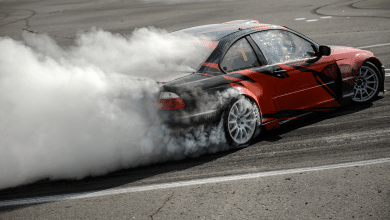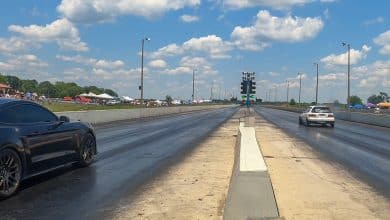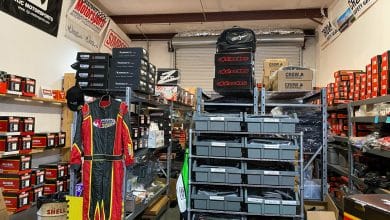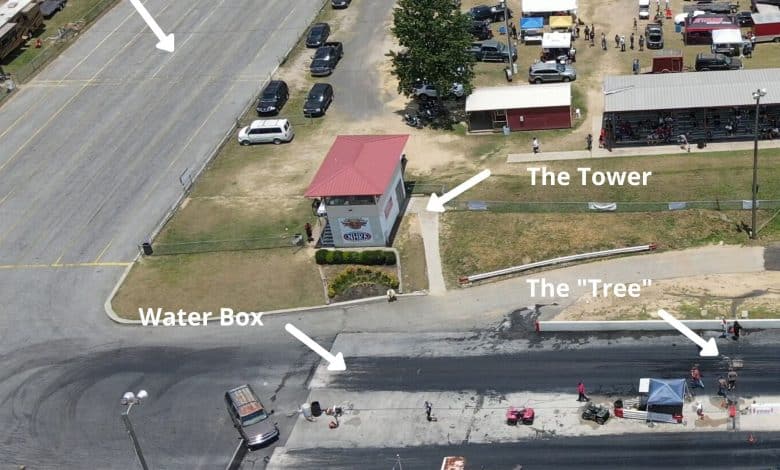
If you are new to drag racing, or just haven’t been in a while and need a refresh, this primer is a great place to start. The process can be intimidating. Our goal is to help demystify going to the drag strip. As one of the most accessible forms of racing it’s something every car enthusiast should do.
Types Of Competitions And Events
Drag racing has a number of styles and types and beyond that, each different event or series class has it’s own rules. Since this is just a primer, we are not going to go into detail on each of the types of class available. We are going to cover the more broad types of racing so you can find events that are best for your first time, or at least your first time back out in a while. This will help you figure out the kind of event best suited for you.
Test And Tune
You will hear this term often when it comes to drag racing. It’s also sometimes referred to as “open timed runs”. Essentially its the opportunity for racers to “Test” their setups and “Tune” or make necessary changes to their cars. While the the original idea was based around time for competitors to work on their cars, it’s become a catchall for drag racing with no specific competitions, classes or objectives. Just line up and run.
This is the type of event most new drag racers will want to go to. There are no prerequisites or prizes and the only competition is to beat the guy next to you, and even that is optional. At most tracks they will even help you get lined up with friends, so you can race who you want to rather than a random stranger. As a new driver you can, and probably should, completely ignore who you are racing against. Just focus on giving it a try and having fun. There will be lots of opportunity to get into the competitive side. While that can be easier said than done,. During text and tune you can get 5, 10, 15 passes in an event, even if it is crowded.
Bracket Racing
Another common form of drag racing is bracket racing. While there are many very serious bracket racing competitors, it does have appeal for those just getting into the scene. What makes bracket racing unique from most other forms of drag racing is that while it still is “fastest one to the end of the track”, the slower car actually go first, depending on the predicted speed of the car.
The idea being the extra lead to the slower car means they’ll finish the race at nearly the same time. It creates an exciting race even when the two cars may be mismatched. It also rewards consistency over speed, reliability over horsepower.
Think of it like a handicap in golf. It works where each driver “predicts” the speed they may go. The driver has to got as close to that time without going faster. If you go faster, you automatically lose.
In larger races with a lot of different types of cars they will be put into brackets. This groups cars by similar speed, for example 10.50 or 11.50. This represents the general speed they go down the track. The idea being without needing to regulate the type of car or the mods, similar cars of similar speed go together. This also helps create exciting racing. In some cases you’ll get daily drivers going up against dedicated drag cars. Bracket racing helps make races like this exciting, even when it’s a total mismatch.
However, brackets by speed are generally more fun to watch. Even if bracket racing makes Dodge Stratus going up against a full race Mustang more exciting, it’s still not as fun as like competitors
From the standpoint of getting into competitive racing – don’t worry about the type of bracket racing. Just get some test and tune passes in and figure out a speed you can go consistently, good or bad and use it as an opportunity to become a better racer. You’ll have plenty of opportunity to get fancy later. Once you are consistent in your launches and speed, then you can focus on finding the most competitive bracket racing.
Heads Up Racing
This is the type of racing most people think of when they think drag racing. It’s the kind you see on NHRA on TV. Cars line up, the lights go green and the first car down at the end of the track wins. The concept from a competition standpoint is pretty simple.
What adds complexity to heads up racing is the variety of classes when its done outside of Test and Tune. Most classes have specific rules that regulate who can run and what kind of mods. While sportsman and local events, like the Import Showdown regulate primarily on mods and driveline, but allow a variety of cars, others may be pretty specific.
Classes can be organized by car, driveline, engine cylinders and size, power adders (turbos, surperchargers, nitrous), tire type, weight, speed, modifications, body types, and more. The goal of this primer isn’t to prepare you to build a race car for a specific competition. There is plenty of time for that. And if you are at that level, we’ll have other articles for you to read that go into that more.
For those who are new, while you can ask what class you may qualify for at an event, we highly recommend focusing on Test and Tune passes. At some events the cost of the entry into a class may also be higher depending on how competitive it is. But if you meet the requirements for a class and are a natural, go for it. It’s just more passes and you don’t have a lot to lose.
Drag Strip Types
One of the initial decisions if you decide to go to the track is whether you are going to go to a 1/8th mile track or 1/4 mile track. There is also half mile events, but there are rarely dedicated 1/2 mile tracks. The length refers to the length of the distance between the start and finish lines. The overall length of the pavement is actually twice the length of the track in most instances, the extra space is for slowing down.
1/8th mile tracks consume half the space, so they are often closer to cities and more prevalent. Also, historically high torque V8s have favored 1/8th mile tracks. 1/4 mile tracks are long favored by professional and competitive racers.
When Imports joined the scene they were drawn to 1/4 mile tracks. The high RPM horsepower, lower torque made them better suited for the longer tracks compared to their high torque V8 counterparts. That mentality stuck.
Should I Go To 1/8th Mile or 1/4 Mile Track?
When it comes to the experience of lining up and going down the track, you are not likely to notice a huge difference. When it comes to being new to drag racing go to the closet track that is the least crowded. This way you’ll get a chance to practice the lining up and launches.
If you would be inclined not to go because of crowds and feeling intimated, you might actually find the 1/8th mile tracks better. They are often much less crowded most test and tune nights. Atlanta Motor Speedways Friday competitions being the exception. (sadly, AMS no longer runs Friday night drags).
Otherwise, as noted above 1/4 mile tend to be well suited to lower torque cars and are popular with imports and domestics. 1/8th mile tracks generally draw a more domestics, but many very light imports regularly attend. Close and comfortable is the most important fact, there is plenty of time to learn preferences after you get some experience.
You can see our list of Atlanta Area Drag Strips for a list of all of the 1/4 mile and 1/8 mile tracks, including some information about their open time.
Time Slips Explained
If you are not familiar with the terms most people talk about with drag racing “times” or “time slips”, here is a quick primer.

Time
The “time” on a time slip or “Elapsed Time” (ET) is how long it took the vehicle to break the laser/lights at the beginning of the track until it went through the laser/light at the end of the track. In general conversation it’s usually the time is used to discuss how fast a car is. Like any racing time it is the measure of the length of time and how the winner is judged, usually in combination with the reaction time.
This time is 1/4 mile or 1/8th mile depending on the track.
Reaction Time
The reaction time is the time between when the light goes green to start the race and the vehicle crosses the lights/laser. This is usually measured in hundreds of seconds. Experienced racers will look to perfect this and can turn pretty consistently fast.
Reaction Time + Elapsed Time represent who gets to the end of the track first. While rare, it is possible for a car with a faster time to lose in a competitive race because the slower car had a better reaction time, left first and therefore crossed the line first, even though the other car covered the distance more quickly.
For a new racer generally it’s better not to get too hung up on the reaction time. You are better focusing on getting a good launch and enjoying the experience. Once you have a few passes under your belt, then you can focus on improving reaction time.
MPH
This is pretty straight forward, MPH is the speed you are going when you pass the final line. One important thing for new racers to know is to continue pushing the vehicle hard to the end. Wait until you get past the speed signs to slow down. This will give you the maximum MPH.
60 Foot
Your 60 foot time is the time it took your vehcile to cover the first 60 feet from the start. This measure generally indicates how well you launched and how much traction your car has. While its a great stat to know as you work to get better, for your first handful of times at the track its not a critical stat. Just focus on getting better and then the 60 foot will add value.
Other Time Slip Info
Your time slip will contain some other information. However, every track is different.
Car Number – The identifier for your car, since there will be two times on each slip you will know which ones is yours.
330 – Your time to 330 feet from the starting line. Similar to the 60 foot time.
594 – For 1/8th mile tracks this is half way from the starting line.
1/8 mile time and MPH – If you run a 1/4 mile track your time slip will include your 1/8th mile time.
1000 – For quarter mile tracks your time to 1000 feet from the starting line.
Depending on the track your time slip may have other information such as Tree, Dial-In (your estimated time for bracket racing), and lane.
Getting Into The Track
If you’ve never been to a drag strip before the process can seem a little confusing. However, it’s actually pretty straight forward and not unlike visits to other types of race tracks.
Gate Entry
First you’ll go to the “gate” where you’ll pay for entry. For ease, many Test and Tune track nights you’ll also buy what is called a “Tech Card” here. If you are unsure for you event, feel free to ask the person at the gate whether to pay for Test and Tune there or somewhere else.
Gate Entry (or to spectate) is generally per person. It’s usually $10-20. So if you bring friends or family know you’ll generally need to pay for them to enter. Most tracks give discounts or free entry to kids. The age and terms varies by track.
Finally at most tracks you’ll be required to sign a typical waiver. This is pretty common across any kind of race track, and everyone who enters, including spectators are required to sign the entry waiver.
Tech Inspection and Tech Cards
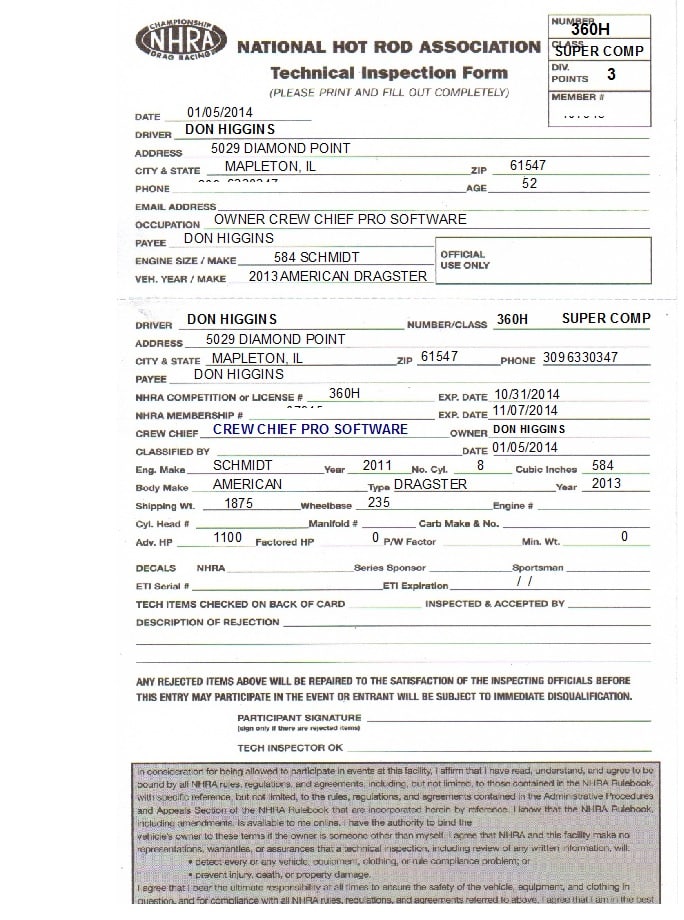
If you are racing and didn’t get your tech card at the gate, the next step is to go the booth that sells “Tech Cards” as they are commonly referred to. Tech Cards are the pass that allow you to race your car and get a Tech Inspection. Generally any “class” you are in is noted on your Tech Card. It also contains personal information and a signature.
For Test and Tune you’ll generally only fill out the top part and sign. You don’t need to worry about having a competition license or number unless you are entering an NHRA sanctioned class. If you were, you probably don’t need to read this article.
Once you have your tech card you’ll go to tech inspection. Tech inspection is for all cars planning on going on the track. During tech inspection your car will be evaluated to ensure it meets the basic safety requirements in order to make passes.
You may also be asked about a class. If you are unsure, your tech inspector is a good person to ask, or you can generally always say “Test and Tune” which is no class, you just want to run.
Safety
As part of the tech inspection you’ll need to understand the safety requirements of Drag Racing. While this is not intended to be an exhaustive list and we always recommend you reference the official rules from NHRA and your track.
While some tracks may be less strict than others, most do follow the NHRA guidelines for safety. For your own protection we recommend you consider the NHRA rules a minimum. For most daily driven street cars without a lot of mods you should not need anything more than a well maintained car. However, below are a few highlights for the most common safety issues.
Clothing
Drivers are required to wear long pants, closed toed shoes and a shirt with sleeves. There are generally zero exceptions to this. While this doesn’t seem like a big deal, on the hot Georgia summer days and nights, forgetting long pants is a lot more common than you might think.
General Car Maintenance
Your car will be inspected for general maintenance. It must not be leaking any fluids, which would make the track slick and dangerous for yourself and other drivers.
The wheel lug nuts must be tight and none of them must be missing. This is often missed because to most people missing a single lug nut on a single wheel seems pretty benign, but it will cause you to fail tech at most tracks. You’ll also need to make sure you have your battery tied down.
Most cars in good working order and maintenance will not have a problem. If you’ve done extensive removal of body parts, have loosely attached items or general maintenance problems, you should get those resolved prior to going to a drag strip. Not only are you likely to fail tech and potentially waste your time and money, if you dropped fluids or parts on the track, they will need to stop racing to clean it up, which takes time away from everyone else getting to make passes.
Helmet
A helmet is generally required for all passes. While the general rule of thumb has been going 13.99 or faster, but many tracks are requiring one for everyone to make passes. In the post COVID-19 era you may not be able to borrow a helmet. If you plan on visiting any tracks or events, investing in even an inexpensive Snell rated helmet is a great idea.
Roll Bar
For convertibles that run faster than 13.49 that do not have a hard top (attachable or retractable), you’ll need a roll bar. This can quickly become a barrier for convertible owners with quick cars.
Other Safety Considerations
Cars that go faster than 11.49 or 10.99 bring a number of stricter safety rules. This include roll bars, racing jacket, and SFI approved seat belts. Ten years ago these speeds were almost exclusively the domain of dedicated racers.
While most beginning drag racers will not get near these times, we mention them because as cars are getting faster and faster from the factory it is becoming easier and easier to hit theses ceilings. You can buy used cars that do this 100% stock from the factory now, which was unheard of when these rules were written.
While some smaller tracks may be forgiving on some of the rules at these higher speeds if they are factory, many tracks will not for liability reasons.
Staging and Launching
If there is an area that gives new drag racers angst it is staging and launching. While it shouldn’t, we certainly understand why. It’s the most nuanced part of drag racing. It’s also the biggest area of skill and practice needed for the average drag racer.

Staging Lanes
Entry into the actual drag strip is known as a the staging lanes. There are usually 8, but the number may vary for each event. For Test and Tune nights generally all all lanes are open to anyone one. For racing events its not uncommon for only certain lanes to be for practice or test and tune.
There is almost always someone at the start of the staging lanes (known as “top of the lanes”) you can ask questions or help you get paired up with a friend. Don’t hesitate to ask, that is what they are there for.
While it may take a while to get through the staging lanes during busy events, it is perfectly normal to stop your car, get out and chat with friends or other racers while working through the lanes. Just don’t wander too far from your car.
Once you get to the “bottom of the lanes” someone will direct you when you to pull up. Do not pull forward towards the staging area unless you’ve been directed to do so.
Staging
There are several pieces of staging you should be aware of as a new drag racer.
Before you go to stage take everything unnecessary or loose out of your car. Hopefully you came with a friend who can watch your stuff, or its not valuable and you are comfortable just leaving it in your parking space. You’ll see plenty of other people do the same. If you are going alone, try to clean out anything unncessary first.
Spare tires, jacks and other heavy objects just add weight to your car. And loose objects can move around during the launch.
The Waterbox
The first thing you’ll encounter as you pull from the staging lanes to the staging area is the water box. The water box is there to get water on the tires of cars that want to do a burnout to warm up their tires. Its an absolute thrill to get to do a huge smokey burnout. If you know how to do it and want to give it a try you can, but for most beginners regardless of type of car, we recommend you skip this step.
You should drive around the water box if you are not going to use it. Most non competitive FWD and AWD cars should ALWAYS drive around the water box. If you go through the water box and do not do a burnout you just leave water on the ground further down from the box. This makes the area slicked for those who do need it.
Bottom line if you don’t know how to use the water box, drive around it. It’ll save you the potential embarrassment.
Staging Area
Once you pass the water box you are in the staging area. There will be a track official there to direct you to pull up to the tree. Before you worry about the lights, a few things you should always do in the staging area:
- Check your helmet is strapped
- Roll up your windows
- Make sure your AC and any other accessories are off
- Turn off your stereo!
- Disable traction control
For that last point, because tracts are covered with VHT to make them sticky they tend to fool most modern traction control systems. It’s generally recommended you disable them. Note: Do so carefully and be cautious with your launch. While highly unlikely if you have a high horsepower car, especially RWD and you launch too hard it is possible to lose control if you are not used it. Our recommendation is to disable traction control but launch carefully the first time for those who are new to drag racing. However, if you are unsure, leave the traction control on. You won’t get a great launch but it is the safest option until you have some practice.
At this point your attention should be focused on the track official for instructions and the tree. While there is potentially a lot going on, including smoky burnouts, don’t let it distract you.
When you get waved up by the track official, go ahead and pull up to the tree. But do this SLOWLY, you don’t want to drive through the lights and have to back up.
Also, because there is a lot going on you don’t want to have to go forward, back up, etc a lot. Make sure you are in Drive/1st gear for a manual and try not to leave it. You don’t want to be the person who accidentally launches in reverse.
The “Tree”
Staging at the tree (also called a “Christmas Tree” is what people think of when drag racing. It can feel a little overwhelming with the nerves going, but its actually fairly straight forward. There are two key elements. The Yellow/Green lights that tell you to get ready and go and the two staging lights on the top.

Staging Lights
In order to get ready you must first stage up. There are two staging lights. One that lets you know your tire has entered the sensor area for staging. The second comes on when the laser/light sensor detects you tire being centered in the area.
The process is pretty simple. Drive slowly, like you are pulling in a driveway at your house, until the first light comes on. Hit the brakes and then creep slowly forward until the second light comes on.
This is time to get ready. Stay in gear (if manual) and stay in drive (automatic/dual clutch). If you have lauch control and feel comfortable using it, this is a time to enage it. Rev up and get ready.
Once you get the first and second lights come on the track official will push a button that starts the count down.
Countdown
There are two types of lights countdowns. We’ll touch briefly on Pro Tree just for information. The vast majority of Test and Tune events will run Regular Tree. For new racers we highly recommend regular tree if asked.
Regular Tree aka .500 Tree
- The lights come on in order down the tree until the final one, which is green
- The time between the last yellow light and the green is half a second (hence the .500 tree name)
Pro Tree aka .400 Tree
- All of the yellow lights come on once
- They all go off and then the green comes on
- The time between the lights going off and the green coming on is .400 seconds (hence the name)
Timing The Countdown
For most first time drag racers, don’t worry about trying to time the countdown. When you see green, focus on the launch. In competitions the reaction time can be the difference between winning and losing. But for first timers your time is more important. Focus on getting the car launched and off of the line. Nobody cares it takes you an extra half second to launch. They do care what time they get and how well they go.
Once launching becomes second nature you can work on the timing and getting a better reaction time.
Going Down The Track
Going down the track is generally pretty easy. If you have an auto or a dual clutch you pretty much just need to focus on keeping your foot all the way down. In a manual the speed and quality of your shifts matter. The more time you can stay in the power, the better. However, for your first few times don’t try to over do it. You don’t want to grind your gears or miss a shift. Just make good, clean shifts. You’ll have plenty of chance to practice and get faster.
Reaching The End
There are a few things to be aware of at the end of the track. Your heart will be racing, you’ll be excited because you potentially hit triple digits in your car. You will even be eager to see how you did, even if it’s your first time.
The signs at the end of the track that show your time are the end point.
Before you get too excited be sure to:
- Make sure you stay into the power until your entire car has passed the signs at the end of the track.
- Don’t try to look at the sign to see your time, stay focused. You’ll get a time slip with your time so you are not missing anything.
- Don’t feel the need to brake immediately, slow down a little and then brake. There is plenty of room to slow down.
- If you miss a turn off DO NOT back up or turn around. There are additional turn offs (at least 2, usually 3 in total). Just go to the next one.
Picking Up Your Time Slip
Last thing you need to do as you are driving back to park, or return to the staging lanes, you can stop at pick up your time slip. There is generally a little building you can pull up to with a person inside. They’ll handle you a printed slip with your times.
Your Time
So you just finished your first pass, you get your first time slip. You’ve read this article. You’ve been on Motortrend and Wikipedia looking up the factory quarter mile time on your car…. and you are way off.
It can be disheartening. Worse you may have mods and assumed you should be able to go even faster. What happened?
First, there are some things you should know about those magazine quarter mile times. They are often in juiced cars, with professional drivers in ideal conditions. Ford, Porsche, BMW, Nissan and the rest of the manufactures certainly don’t want a poor number published. They go out of their way to enforce the conditions.
There are other factors. Your weight, the amount of fuel, the number of other items in your car, the temperature outside, the altitude all have an impact. It can easily vary your time from facfory by a second or more, even with an experienced driver.
If this is among your first times you may have more to work on figuring out the best way to launch your car. The start has a huge impact on the overall speed. Remember when we suggested you take it easy and just get going, get the feeling first? Well, we’re sorry but we probably did make your time worse. But its better than being embrassed. Plus if you did launch poorly trying too hard, your time would still be bad.
Go back and keep working on your launch. The better it gets, the better the time will. Mods, practice and consistency matter. It may never get your car to a magazine time, but there is plenty of opportunity to get good.
Track Facilities
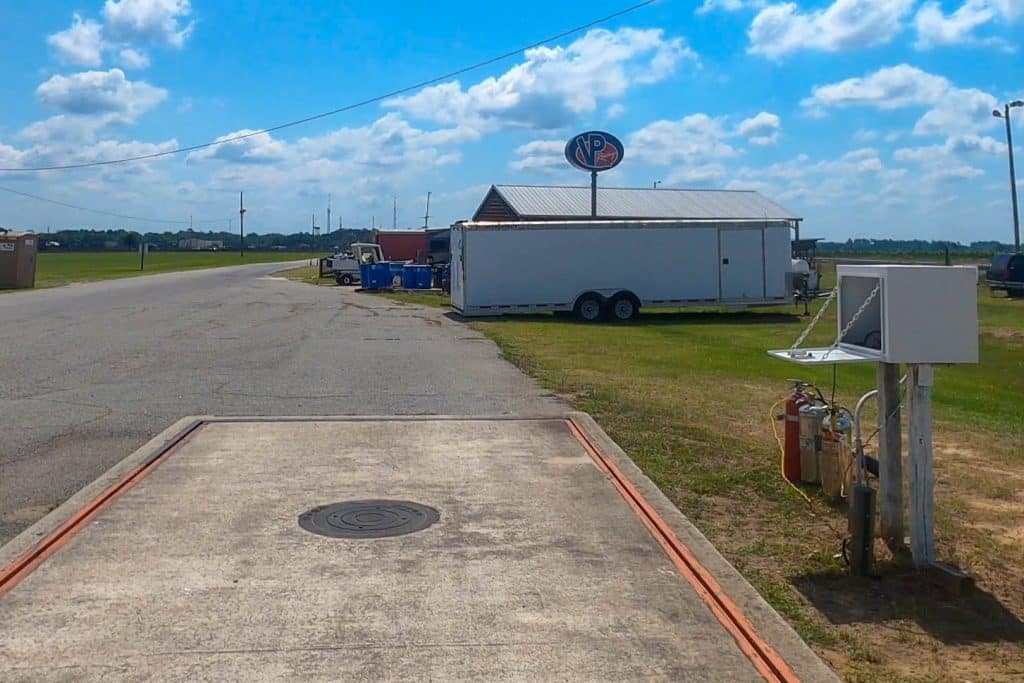
Racing Fuel
Most drag strips offer Racing Fuel. The brands and octanes, and whether they are leaded or not will depend on the facility. For most beginners there ins’t any benefit. Unless you have a modified ECU that can take advantage of the higher octane you won’t likely benefit much from it. Stick to 93. If you do have a map on your ECU from a tune that supports higher octane fuel, don’t forget to grab some.
In the future, its there if you want it.
Scales
Ever wanted to know what your car weighs, and what it weighs with you in it. The actual drive weight of your car? Most drag strips offer free scales where you can weigh your car (including yourself, if you desire). While they are primarily there for classes that need to enforce a specific weigh limit, the scales are generally open during many Test and Tune events to support racers.



